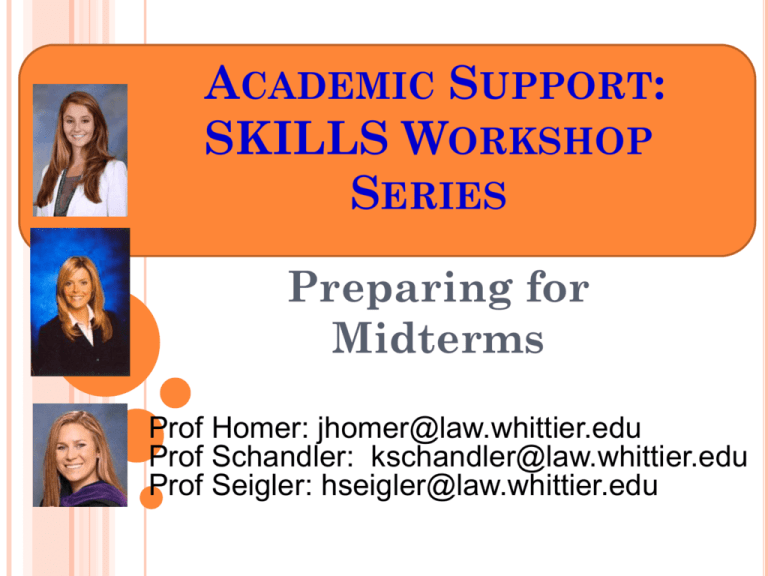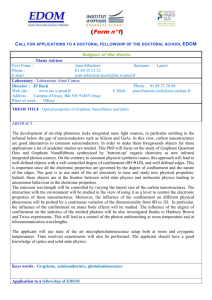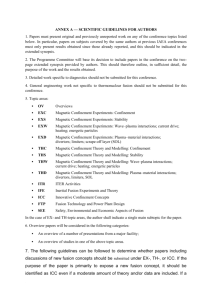Intent - Whittier Law School
advertisement

ACADEMIC SUPPORT: SKILLS WORKSHOP SERIES Preparing for Midterms Prof Homer: jhomer@law.whittier.edu Prof Schandler: kschandler@law.whittier.edu Prof Seigler: hseigler@law.whittier.edu OVERVIEW OF WORKSHOPS Fundamentals of law school Reading, briefing, outlining Preparing for midterms More on outlining, essay questions, exam prep Learning from midterms and preparing for final exams Fine tuning your outlining and test taking skills through the substantive lens of CivPro/CrimLaw Why we have midterms THIS IS YOUR FIRST OPPORTUNITY TO ASSESS: Your ability to comprehend what you’re reading Your ability to issue spot as you read Your ability to organize the issues, while prioritizing your time and “hot issues” Your ability to analyze Your ability to write clearly and accurately Your ability to do all of this…. Quickly HOW TO PREPARE? LAW SCHOOL STUDY CYCLE Read, brief, class notes Review Class notes for understanding Update Outline Practice Exams/ Review Sessions Assess what you know Adjust Outline SO… WHO HAS STARTED OUTLINING? <Every hand should be raised!!!> CREATING AN OUTLINING FROM BRIEFS/IN-CLASS NOTES McCann v. Wal-Mart Stores, Inc. 210 F.3d 51 (1st Cir. 2000). Parties: ∏—McCann family shopping at Wal-mart ∆—Wal-Mart Reasoning: Confinement can be based on a false assertion of legal authority to confine. Moral pressure is not enough Test: Would a reasonable person believe they were unable to leave? If they believed the cops are coming, probably Duress of Goods—If the ∆ takes property and the person would have to leave behind the property in order to leave Facts: The McCann mother and her sons were shopping at a Wal-Mart They were mistaken for another family who had been forbidden to shop there Wal-Mart asserts that there must be actual, physical restraint, quoting (the other family had a son who'd been caught shoplifting). (Kowlton v. Ross); The language is taken out of context and was simply used The Wal-Mart employees detained the family, saying that they had to stay and to illustrate that in no way was the plaintiff in that case restrained. that they were calling the police. How long do you have to be “falsely imprisoned” to have The McCanns were there at Wal-Mart's behest for about an hour. Security officer arrived and said the McCanns were not the forbidden family a claim? Would it have mattered if they were the family forbidden to An appreciable amount of time. shop there? Does this count as confinement? They still would have been confined, but they may have had Yes. They didn’t have legal authority and it was for an legal authority. appreciable amount of time. Procedure: The McCanns sued for false imprisonment. $20k to ∏. Wal-Mart appeals. Issue: Were the McCanns actually confined? Holding: Yes. Rule: A false imprisonment is the intentional confinement of another in a fixed boundary for an appreciable amount of time, with no reasonable means of escape. Shopkeeper’s Privilege—Qualified privilege to detain for a reasonable amount of time, in order to recapture property as long as you have reasonable belief that that they stole the property and act within a reasonable time and reasonable manner. To investigate Ownership of the Property: 1. Reasonable belief someone stole the property 2. Reasonable amount of time 3. Detention has to be in a reasonable matter In this case the people didn’t steal anything. But if they were the family in question they would have been considered trespassing. The confinement may be accomplished by Always look for Shopkeepers Privilege Defense on an exam if you 1. Physical barriers; 2. Force or threat of immediate force against the victim, the issue spot FI victim’s family or others in her immediate presence, or the victim’s property; RIEF N LASS 3. Omission where the defendant has a legal duty to act; or OTES 4. Improper assertion of legal authority. B N & I -C HOW DID YOUR CLASS DISCUSSION ENHANCE OR INCREASE YOUR UNDERSTANDING OF THE RULES? False Imprisonment—the intentional confinement to a bounded area with no reasonable means of escape, without consent or authority of law, that the plaintiff is aware of. The confinement may be accomplished by Intent 1. Physical barriers; 2. Force or threat of immediate force against the victim, the Confinement to a bounded area victim’s family or others in her immediate presence, or the with no reasonable means of escape victim’s property; 3. Omission where the defendant has a legal duty to act; or Plaintiff ’s awareness 4. Improper assertion of legal authority. How long do you have to be “falsely imprisoned” to have a claim? An appreciable amount of time. FULL LENGTH OUTLINE—FI RULE: a false imprisonment is the intentional confinement of another in a fixed boundary for an appreciable amount of time, with no reasonable means of escape. ANALYSIS: Intent– purpose, desire, or knowledge to a substantial certainty. Confinement within a bounded area—confinement must be within a bounded area for an appreciable amount of time.: It can be achieved by: a. physical threat b. physical barrier c. force or threat of force d. duress (without legal authority) Moral pressure and future threats are insufficient. Duress of goods—if they take the prop and the person would have to leave it behind to leave Cases to help: •∏ v. ∆—showed that taking the property of another can constitute a FI where if the person left they would not get their prop back=constructive confinement •McCann v. Wal-Mart—an appreciable amount of time of confinement 1 hour in confined area waiting for security Insert cases your Professor identifies as important/need to know No reasonable means of escape—there must be no reasonable means of escape. locked door, closed space, etc. Jumping out of a window is usually not reasonable If victim uses unreasonable means of escape they’re liable for own injuries; unless they think they’ll be harmed in confinement That Plaintiff is aware of: Plaintiff must have knowledge of the confinement. Can be made aware by being injured from the confinement OUTLINING “TYPES” Two types of people “Maximalists” Start big and edit down to something manageable “Minimalists” Start with “skeletons” and fill in the gaps EXAMPLE OF SKELETAL FORM (PLAN OF ATTACK) Battery—The intentional harmful or offensive touching of another’s person. Intent Harmful or offensive standard: Contact Assault—intentionally causing of apprehension of an imminent harmful or offensive contact. Intent Apprehension Immediacy/imminence Harmful/Offensive Contact False Imprisonment—the intentional confinement to a bounded area with no reasonable means of escape, without consent or authority of law, that the plaintiff is aware of. Intent Confinement to a bounded area with no reasonable means of escape Plaintiff ’s awareness LAW SCHOOL STUDY CYCLE Now…what to do with your outline? Read, brief, class notes Review Class notes for understanding Update Outline Practice Exams/ Review Sessions Assess what you know Adjust Outline PRACTICE EXAMS Start taking practice exams in exam-like conditions EXAM WRITING STRATEGY 1 2 3 4 Read the call of the question Read the fact pattern Pre-Write Outline answer with key facts Write exam in IRAC form focusing on analysis Read the call of the ? Read the fact pattern Outline Write in IRAC 1. Read the Call of the Question: HANDOUT Lauren vs. Sister Heidi— What is the call of the Question? False Imprisonment 2. Read the Fact Pattern: Key fact vs non key fact Key fact: if changed or eliminated, would change the outcome of the case- create legal dispute between the parties Non key fact: background facts colorable fact (emotionally charged) red herrings (get you writing an issue that isn’t there)- 2 ways to handle it 1) ignore or 2) tell why it’s not an issue Preclusion facts (“Jenny was negligently injured” or “P and D entered into a valid K)- don’t write about it! 2. Read the Fact Pattern: WHAT TO DO WHILE YOU READ THROUGH THE QUESTION: Pay attention to the facts Key facts vs. non-key facts Take notes/underline/highlight key facts 1 minute read-through! 3. Outline your answer using your outline structure + utilizing key facts : PRE-WRITE OUTLINING Quick How-to: Spend about 20-25% of the allotted time creating a PreWrite Outline 1. Organize your Pre-Write Outline By Issues and Parties 2. Fill your Pre-Write Outline with content that identifies: The Issue Key facts that relate to the issue and or an element of the issue Defenses/counterarguments/privileges 3. Review: The fact pattern to make sure you have used all key facts Use your checklist to ensure you caught all issues 4. Start writing! 3. Outline your answer using your outline structure + utilizing key facts : Let’s Organize the Issues Here, the question directs us to one main issue…. … But what about the elements? Which ones are “hotter” Intentional Confinement within a bounded area With no reasonable means of escape That the plaintiff is aware of Efficiency Tip: Spend more of your time analyzing those “hot” issues PUTTING THE PUZZLE TOGETHER 3. Outline your answer using your outline structure + utilizing key facts : PRE-WRITE OUTLINE YOUR ANSWER Facts to Support/∏’s arg. Intent Confinement w/ no reasonable means of escape Without Consent or Authority of Law Plaintiff Awareness Facts that don’t Support/∆’s arg. 3. Outline your answer using your outline structure + utilizing key facts : Facts to Support/∏’s arg. Intent Heidi led Lauren to small room in cellar, told her to remain inside H purposefully placed L in the room for the “encounter” Confinement With No Reasonable Means of Escape Plaintiff Awareness Facts that don’t Support/∆’s arg. Room inside a cellar— underground, usually no other doors/windows Nuns prayed on the outside of door No facts re: whether H’s intent was to imprison L or if her intent was to have L participate by remaining in the cellar room No facts specifically stating the door was closed (but you could prob assume it was) L did not make any attempts to leave Room inside a cellar—underground, usually Facts do not mention lock on door no other doors/windows Never attempted to leave, controlled breathing, Nuns might have been blocking door fell asleep= participating in exercise L had claustrophobia—maybe consumed by fear and couldn’t move L had history of claustrophobia so she was more prone to notice enclosed spaces Shouted that she was frightened Controlled her breathing—panicking due to her awareness Not injured during the confinement She fell asleep so she was not aware of the confinement at that time Analysis= explaining WHY these facts support the element 4. Write exam in IRAC form focusing on analysis: IRAC—A TRANSFERABLE SKILL McCann v. Wal-Mart Stores, Inc. 210 F.3d 51 (1st Cir. 2000). Issue Parties: Rule ∏—McCann family shopping at Wal-mart, ∆—Wal-Mart Battery—The intentional harmful or offensive touching of another’s person. Facts: Intent The McCann mother and her sons were shopping at a Wal-Mart Harmful or offensive standard: Analysis They were mistaken for another family who had been forbidden to shop there Contact The McCanns were detained there at Wal-Mart's behest for about an hour. Security officer arrived and said the McCanns not the forbiddenof family Assault—intentionally causing were of apprehension an imminent harmful or offensive contact. Procedure: The McCanns sued for false imprisonment. $20k to ∏. Wal-Mart appeals. Intent Issue: Apprehension Were theMcCanns actually confined? Immediacy/imminence Rule: Harmful/Offensive Contact A false imprisonment is the intentional confinement another in a fixed for anarea appreciable False Imprisonment—the intentionalofconfinement toboundary a bounded with no amount of time, with no reasonable means of escape. reasonable means of escape, without consent or authority of law, that the plaintiff is aware of. Reasoning/Analysis: Intent Confinement can be based on a false assertion of legal authority to confine. asserts Confinement to abebounded arearestraint, with no reasonable escape Wal-Mart that there must actual, physical quoting (Kowltonmeans v. Ross);ofThe languageis taken out of’scontext and was simply used to illustrate that in no way was the plaintiff in Plaintiff awareness that case restrained. Holding/Conclusion: Yes. 4. Write exam in IRAC form focusing on analysis: IRAC I: Issue- What is the issue raised by the call of the question? Are there sub-issues involved? R: Rule- Give a concise but accurate statement of the black letter law. A: Analysis- Thorough application of the facts to the rule. FACTS + WHY! Use “mini IRACs” C: Conclusion- Short conclusion. One to two sentence only. 4. Write exam in IRAC form focusing on analysis: C I (black letter law [aka “rule”], accurate and concise) Example: Intentional confinement within a . . . i r a c i r a c (break down element #1 w/ heading) Example: Intentional (rule for element #1) Example: Rule statement for intent (fact+why fact is important for element #1) (conclude for element #1—whether it was met or not) (continue making mini-iracs per element, w/ headings for each) (overall conclusion—1 sentence!) Issue #2 (State parties involved + COA for next issue spotted) One issue (ex. False Imprisonment) I R A Issue #1 (with heading) (State parties involved + COA [aka issue]) Example: the issue here is whether… 4. Write exam in IRAC form focusing on analysis: ANALYSIS = FACTS+WHY It’s not enough to list the facts that are relevant to each element, you must explain WHY they are relevant For Example: “Sister Heidi led Lauren into the room and instructed her to stay inside. Sister Heidi willfully confined Lauren. CONCLUSORY Vs. “Sister Heidi (SH) “led” Lauren (L) into the room, which shows that SH wanted L to go inside the cellar. SH also “instructed” L to remain inside the cellar which establishes that SH intended for L to not only step into the cellar room but also wanted her to remain within the confines of the small cellar. Therefore, SH’s actions show she intended to confine L.” ANALYZES Fact + Why 4. Write exam in IRAC form focusing on analysis: EXAMPLE OF AN “A” ANSWER VS. “C” ANSWER See handout: What do you notice right away? LAW SCHOOL STUDY CYCLE Read, brief, class notes Review Class notes for understanding Update Outline Practice Exams/ Review Sessions Assess what you know Adjust Outline ASSESSMENT & COMPONENTS OF AN “A” ANSWER Organization: Analysis: Comprehension: Was it easy to Did you catch all Did you make up organize an issues key issues? or misstate facts answer based on Did you catch all OR did you make how your outline logical inferences? key facts/hot is structured? issues? Was your outline Did you identify in IRAC? counter arguments & affirmative defenses? OVERALL MIDTERM STRATEGY: Know your rules statements cold Issue spot, issue spot, issue spot Use Answer the call of the question all key facts Use IRAC structure Discuss BOTH sides of the argument— when applicable An Exam Writing Workshop Presented by BARBRI Bar Review FIRST YEAR LAW SCHOOL SUCCESS Live Lecture @ WLS: Saturday October 6, 2012 9:00 a.m. – 1:30 p.m. Room 14—COMPLETELY FREE *Bring your yellow BARBRI Book NEXT WORKSHOP Learning from Midterms and Preparing for Final Exams Section A: Thurs. Nov 15 12-1 in room 8 Section B: Wed. Nov 14 2-3 in room 10 Section C: Tues. Nov 13 12-1 in room 12








